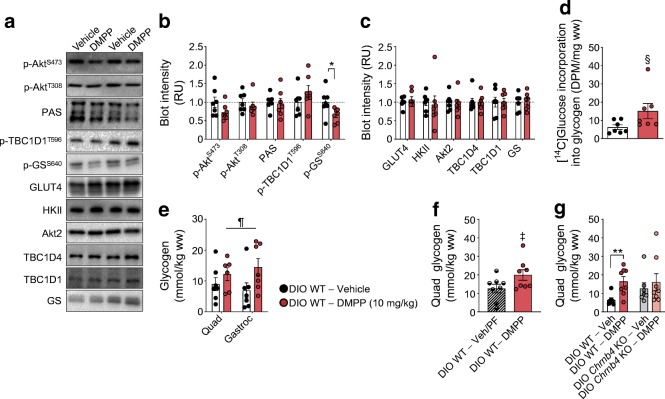Fig. 5.
DMPP increases non-oxidative glucose disposal in skeletal muscle. (a–c) Representative western blots and quantification of indicated protein phosphorylation residues or total proteins, relative to total protein, in quadriceps muscle from DIO WT mice treated as described in Fig. 4. (d, e) [14C]Glucose incorporation into glycogen and glycogen content in quadriceps (Quad) and gastrocnemius (Gastroc) muscles from DIO WT mice treated as described in Fig. 4. (f) Quadriceps muscle glycogen from vehicle-treated pair-fed (PF) and DMPP-treated mice (10 mg/kg); and (g) from vehicle- or DMPP-treated DIO WT and Chrnb4 KO mice (10 mg/kg). The key next to (e) applies to (b–e). All data are presented as mean ± SEM. For (a–e) n = 7, except for DMPP-treated quadriceps muscle in (e) for which n = 6, because of insufficient material for one of the samples; (f) n = 8; (g) n = 7–8. Differences were probed with two-tailed Student’s t tests for (b, c, d, f, g) comparing the means of vehicle and DMPP. Data in (e) were analysed with two-way repeated measures ANOVA (muscle × drug). *p ≤ 0.05, **p ≤ 0.01 for DMPP compared with vehicle; §p = 0.064 for DMPP compared with vehicle; ¶p ≤ 0.05 main effect of DMPP; ‡p ≤ 0.05 vehicle-treated pair-fed compared with DMPP. DPM, disintegrations/min; GS, glycogen synthase; HKII, hexokinase II; RU, relative units; ww, wet weight

